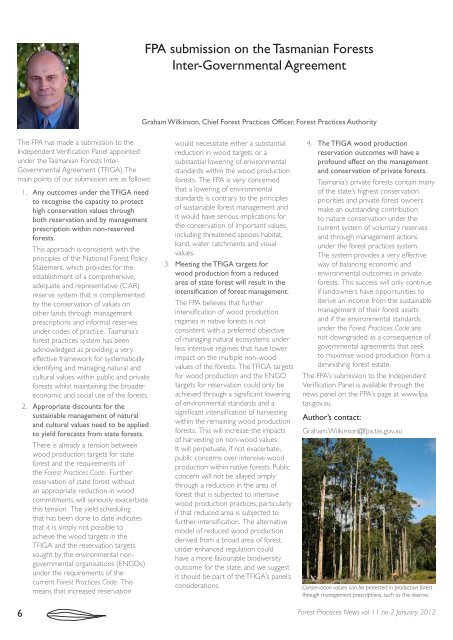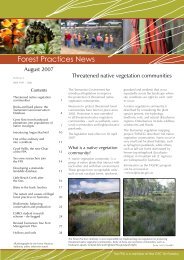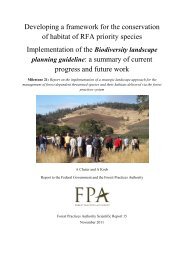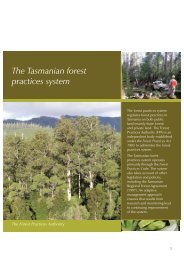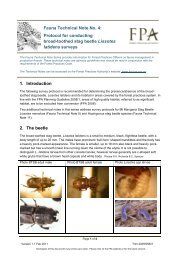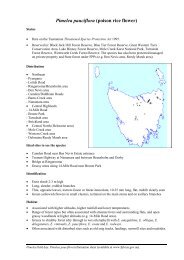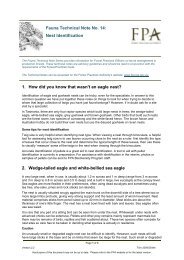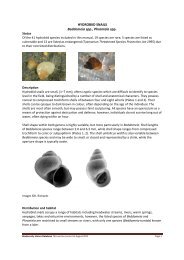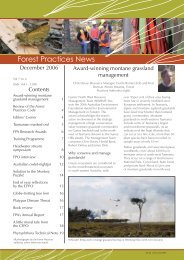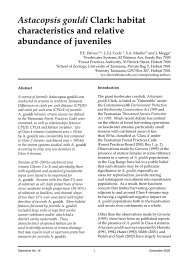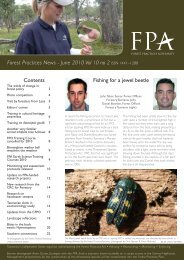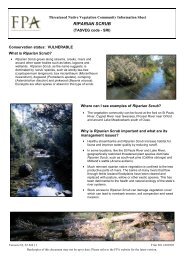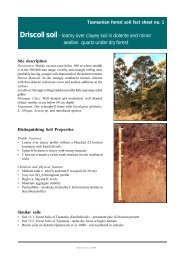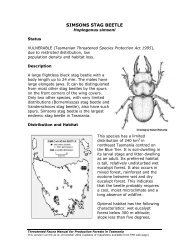FPN vol 11 no 2 January 2012 - The Forest Practices Authority
FPN vol 11 no 2 January 2012 - The Forest Practices Authority
FPN vol 11 no 2 January 2012 - The Forest Practices Authority
Create successful ePaper yourself
Turn your PDF publications into a flip-book with our unique Google optimized e-Paper software.
FPA submission on the Tasmanian <strong>Forest</strong>sInter-Governmental AgreementGraham Wilkinson, Chief <strong>Forest</strong> <strong>Practices</strong> Officer, <strong>Forest</strong> <strong>Practices</strong> <strong>Authority</strong><strong>The</strong> FPA has made a submission to theIndependent Verification Panel appointedunder the Tasmanian <strong>Forest</strong>s Inter-Governmental Agreement (TFIGA). <strong>The</strong>main points of our submission are as follows:1. Any outcomes under the TFIGA needto recognise the capacity to protecthigh conservation values throughboth reservation and by managementprescription within <strong>no</strong>n-reservedforests.This approach is consistent with theprinciples of the National <strong>Forest</strong> PolicyStatement, which provides for theestablishment of a comprehensive,adequate and representative (CAR)reserve system that is complementedby the conservation of values o<strong>no</strong>ther lands through managementprescriptions and informal reservesunder codes of practice. Tasmania’sforest practices system has beenack<strong>no</strong>wledged as providing a veryeffective framework for systematicallyidentifying and managing natural andcultural values within public and privateforests whilst maintaining the broadereco<strong>no</strong>mic and social use of the forests.2. Appropriate discounts for thesustainable management of naturaland cultural values need to be appliedto yield forecasts from state forests.<strong>The</strong>re is already a tension betweenwood production targets for stateforest and the requirements ofthe <strong>Forest</strong> <strong>Practices</strong> Code. Furtherreservation of state forest withoutan appropriate reduction in woodcommitments will seriously exacerbatethis tension. <strong>The</strong> yield schedulingthat has been done to date indicatesthat it is simply <strong>no</strong>t possible toachieve the wood targets in theTFIGA and the reservation targetssought by the environmental <strong>no</strong>ngovernmentalorganisations (ENGOs)under the requirements of thecurrent <strong>Forest</strong> <strong>Practices</strong> Code. Thismeans that increased reservationwould necessitate either a substantialreduction in wood targets or asubstantial lowering of environmentalstandards within the wood productionforests. <strong>The</strong> FPA is very concernedthat a lowering of environmentalstandards is contrary to the principlesof sustainable forest management andit would have serious implications forthe conservation of important values,including threatened species habitat,karst, water catchments and visualvalues.3. Meeting the TFIGA targets forwood production from a reducedarea of state forest will result in theintensification of forest management.<strong>The</strong> FPA believes that furtherintensification of wood productionregimes in native forests is <strong>no</strong>tconsistent with a preferred objectiveof managing natural ecosystems underless intensive regimes that have lowerimpact on the multiple <strong>no</strong>n-woodvalues of the forests. <strong>The</strong> TFIGA targetsfor wood production and the ENGOtargets for reservation could only beachieved through a significant loweringof environmental standards and asignificant intensification of harvestingwithin the remaining wood productionforests. This will increase the impactsof harvesting on <strong>no</strong>n-wood values.It will perpetuate, if <strong>no</strong>t exacerbate,public concerns over intensive woodproduction within native forests. Publicconcern will <strong>no</strong>t be allayed simplythrough a reduction in the area offorest that is subjected to intensivewood production practices, particularlyif that reduced area is subjected tofurther intensification. <strong>The</strong> alternativemodel of reduced wood productionderived from a broad area of forestunder enhanced regulation couldhave a more favourable biodiversityoutcome for the state, and we suggestit should be part of the TFIGA’s panel’sconsiderations.4. <strong>The</strong> TFIGA wood productionreservation outcomes will have aprofound effect on the managementand conservation of private forests.Tasmania’s private forests contain manyof the state’s highest conservationpriorities and private forest ownersmake an outstanding contributionto nature conservation under thecurrent system of <strong>vol</strong>untary reservesand through management actionsunder the forest practices system.<strong>The</strong> system provides a very effectiveway of balancing eco<strong>no</strong>mic andenvironmental outcomes in privateforests. This success will only continueif landowners have opportunities toderive an income from the sustainablemanagement of their forest assetsand if the environmental standardsunder the <strong>Forest</strong> <strong>Practices</strong> Code are<strong>no</strong>t downgraded as a consequence ofgovernmental agreements that seekto maximise wood production from adiminishing forest estate.<strong>The</strong> FPA’s submission to the IndependentVerification Panel is available through thenews panel on the FPA’s page at www.fpa.tas.gov.au.Author’s contact:Graham.Wilkinson@fpa.tas.gov.auConservation values can be protected in production forestthrough management prescriptions, such as this reserve.6 <strong>Forest</strong> <strong>Practices</strong> News <strong>vol</strong> <strong>11</strong> <strong>no</strong> 2 <strong>January</strong> <strong>2012</strong>


